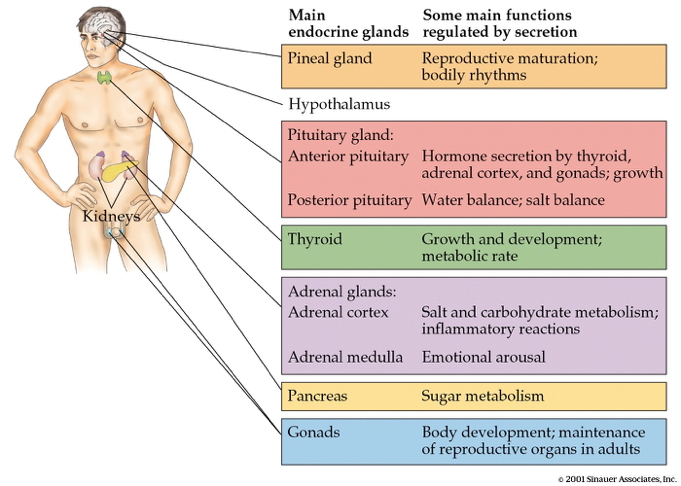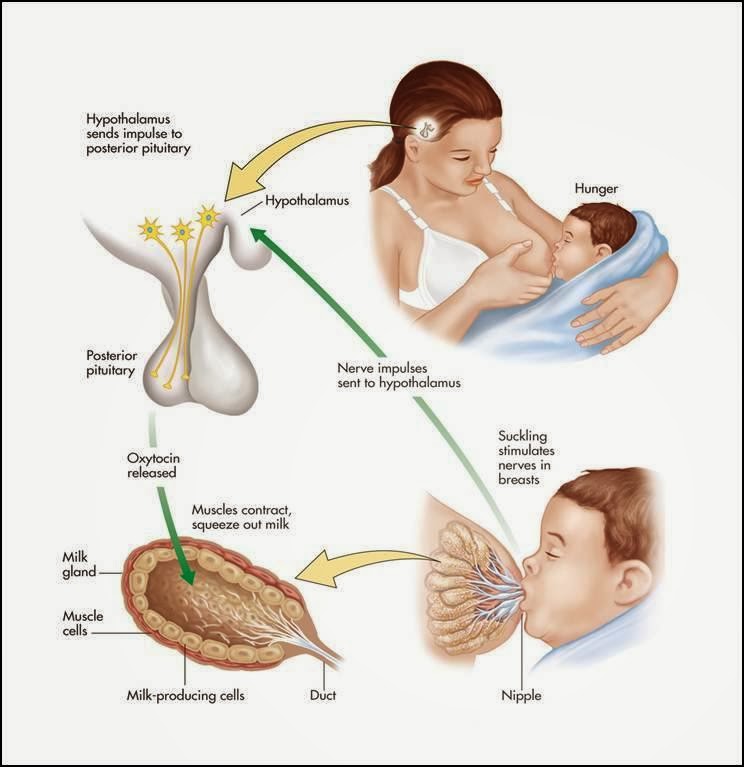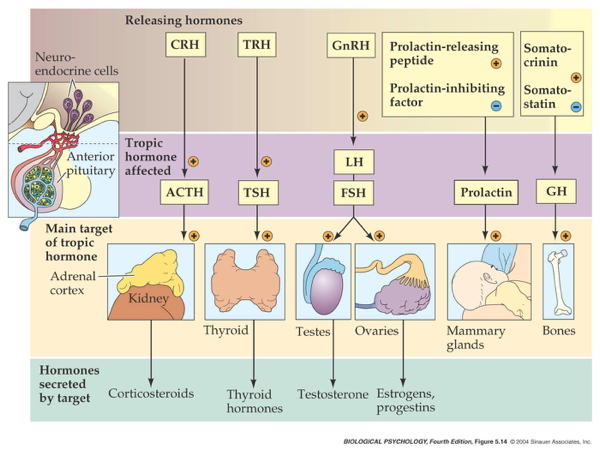Topic 9 Hormones and the brain
Background
Hormones are…
- Chemicals secreted into blood
- Act on specific target tissues via receptors
- Produce specific effects
Can a substance be a hormone AND a neurotransmitter?
Yes, if the substances are 1) released by neurons, 2) bind to neurons, and 3) bind to other cells in the body.
Substances that are both hormones and neurotransmitters
- Melatonin
- Epinephrine/adrenaline
- Oxytocin
- Vasopressin
Physiological responses and behaviors under hormonal influence

- Ingestive (eating/ drinking)
- Fluid levels
- Na, K, Ca levels
- Digestion
- Blood glucose levels

Figure 9.1: Snails mating: http://2.bp.blogspot.com/-LziO1SbCVbU/UeqmTPOCJiI/AAAAAAAACUI/u7mCG4vlf_U/s1600/reprodution.JPG+51.jpg
- Reproduction
- Sexual Maturation
- Mating
- Birth
- Care giving

- Responses to threat/challenge
- Metabolism
- Heart rate, blood pressure
- Digestion
- Arousal
Biology

- Rest of body
- Thyroid
- Adrenal (ad=adjacent, renal=kidney) gland
- Adrenal cortex
- Adrenal medulla
- Gonads (testes/ovaries)
- CNS
- Hypothalamus
- Pituitary
- Anterior
- Posterior
- Pineal gland
Case studies
Case 1: Responses to threat or challenge
- Neural response
- Sympathetic Adrenal Medulla (SAM) response
- Sympathetic NS activation of adrenal medulla, other organs
- Releases NE and Epi
](https://journals.physiology.org/cms/10.1152/physrev.00042.2017/asset/images/medium/z9j0041828650001.gif)
Figure 9.3: Deussing and Chen (2018)
- Endocrine response
- Hypothalamic Pituitary Adrenal (HPA) axis
- Hypothalamus
- Corticotropin Releasing Hormone (CRH)
- Anterior pituitary
- Adrenocorticotropic hormone (ACTH)
- Adrenal cortex
- Glucocorticoids (e.g., cortisol)
- increases blood glucose, anti-inflammatory
- negative consequences of prolonged exposure
- Mineralocorticoids (e.g. aldosterone)
- Regulates Na (and water) retention in kidneys
- Glucocorticoids (e.g., cortisol)
Case 2: Reproductive behavior – the milk letdown reflex
- Hypothalamus releases oxytocin into posterior pituitary
- Targets milk ducts in breast tissue

Oxytocin’s multiple roles
- Sexual arousal
- Released in bursts during orgasm
- Stimulates uterine, vaginal contraction
- Links to social interaction, bonding: Weisman and Feldman (2013)
- Alters face processing in autism: Domes et al. (2013)
What are effects of “knocking-out” oxytocin receptors
](include/img/crispr-voles-oxytocin.png)
Figure 9.6: Ledford (2023)
References
Deussing, Jan M, and Alon Chen. 2018. “The Corticotropin-Releasing Factor Family: Physiology of the Stress Response.” Physiological Reviews 98 (4): 2225–86. https://doi.org/10.1152/physrev.00042.2017.
Domes, Gregor, Markus Heinrichs, Ekkehardt Kumbier, Annette Grossmann, Karlheinz Hauenstein, and Sabine C. Herpertz. 2013. “Effects of Intranasal Oxytocin on the Neural Basis of Face Processing in Autism Spectrum Disorder.” Biological Psychiatry 74 (3): 164–71. https://doi.org/http://dx.doi.org/10.1016/j.biopsych.2013.02.007.
Ledford, Heidi. 2023. “CRISPR Voles Can’t Detect ‘Love Hormone’ Oxytocin — but Still Mate for Life.” http://dx.doi.org/10.1038/d41586-023-00197-9. https://doi.org/10.1038/d41586-023-00197-9.
Sikich, Linmarie, Alexander Kolevzon, Bryan H King, Christopher J McDougle, Kevin B Sanders, Soo-Jeong Kim, Marina Spanos, et al. 2021. “Intranasal Oxytocin in Children and Adolescents with Autism Spectrum Disorder.” The New England Journal of Medicine 385 (16): 1462–73. https://doi.org/10.1056/NEJMoa2103583.
Weisman, Omri, and Ruth Feldman. 2013. “Oxytocin Effects on the Human Brain: Findings, Questions, and Future Directions.” Biological Psychiatry 74 (3): 158–59. https://doi.org/http://dx.doi.org/10.1016/j.biopsych.2013.05.026.


](https://journals.physiology.org/cms/10.1152/physrev.00042.2017/asset/images/medium/z9j0041828650004.gif)
](include/img/nejmoa2103583_f2.jpg)